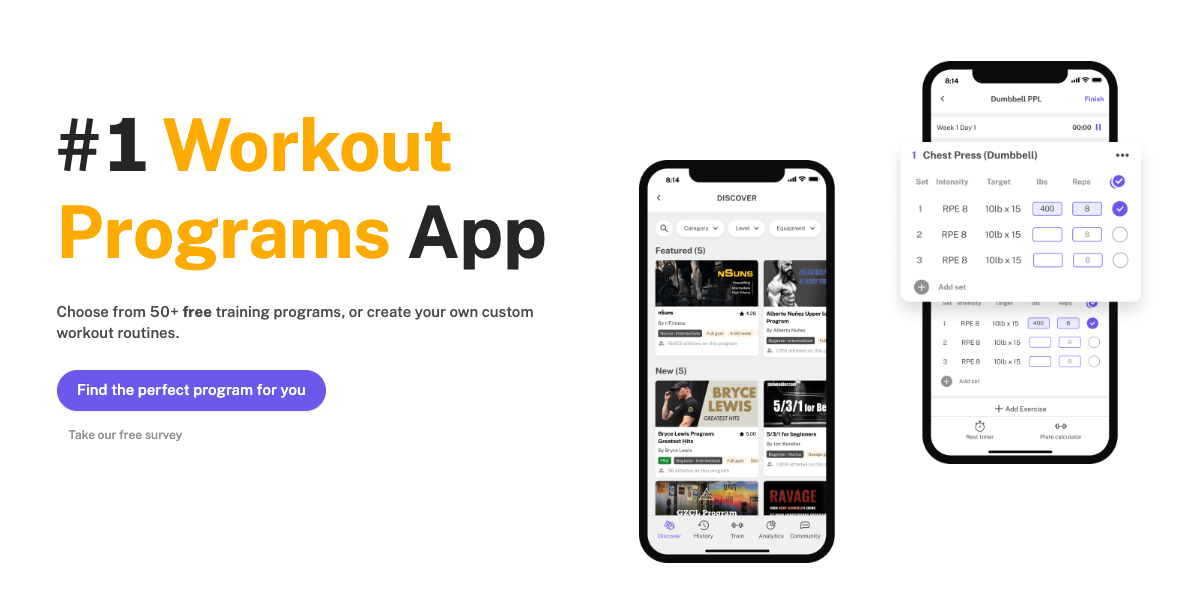Master Functional Strength Training: Essential Guide
Written by the Boostcamp staff
Functional Strength Training Made Easy: Your Ultimate Guide
Have you ever heard of functional strength training? It is a type of training that focuses on movements that can transfer and benefit everyday activities, like lifting groceries or climbing stairs. This type of training has gained popularity in recent years due to its effectiveness in improving overall strength and muscle mass as well as quality of life. Let's look into the concept of functional strength training, including the difference between traditional strength training and functional strength training, the science behind its effectiveness, how it can enhance your daily life, and of course where to find the best training routines.
Whether you're a bodybuilder or a powerlifter that is looking for a new challenge or someone who wants to improve their daily movements and mobility, functional strength training might be just what you need!
Understanding the Concept of Functional Strength Training

Functional strength training is a great way to improve your overall physical well-being. By focusing on exercises that can mimic and transfer over to everyday movements, you can enhance your ability to perform daily activities with ease. This type of training targets multiple muscle groups simultaneously, helping you build functional strength that translates into better balance, stability, and coordination in your daily life. Whether you're lifting heavy objects or simply getting up from a chair, functional strength training can benefit your body's ability to move efficiently. Incorporating exercises like squats, lunges, and overhead presses can help you achieve your fitness goals while improving bone density and the health of your muscles. So why not take a big step towards a stronger, more functional body?
Difference between Functional Strength and Traditional Strength Training
Functional strength training focuses on movements that mimic real-life activities, while traditional strength training typically involves isolated exercises targeting specific muscle groups. In functional strength training, the emphasis is on overall body functionality, rather than just building muscle mass, or strength in a certain lift, like powerlifting does. It incorporates a wide range of movements using bodyweight or functional equipment, instead of relying solely on weightlifting machines or free weights. Functional strength training helps improve your body's ability to perform daily life activities by enhancing balance, stability, and coordination. It's a great way to train your body for the demands of daily life.
The Science Behind Functional Training Effectiveness
Functional training is highly effective due to its ability to engage multiple muscle groups simultaneously, resulting in more efficient workouts. Through functional training, neuromuscular coordination and proprioception can be improved, enhancing overall movement control. Additionally, this type of training promotes joint stability and mobility, preventing injuries and improving daily life functionality. Another benefit is the development of core strength and stability, essential for maintaining proper posture and performing daily activities. Lastly, functional training improves muscular endurance and cardiovascular fitness, making it a great way to improve overall physical fitness.
How does Functional Training Enhance Your Daily Life?
Functional training goes beyond the gym and enhances your daily life. It prepares your body for real life activities and scenarios, improving movement control, balance, and coordination. By preventing common injuries and improving physical capabilities, functional training enhances your overall quality of life.
Functional Strength for Better Balance and Coordination
Functional strength training is a great way to improve balance and coordination through dynamic movements. By targeting stabilizer muscles, it helps maintain balance in various positions and activities. This type of training also enhances proprioception, improving body awareness and control. Better balance and coordination acquired from functional strength training can help prevent falls and enhance overall stability. Additionally, the exercises involved in functional strength training improve coordination between different muscle groups, further enhancing the body's ability to move efficiently.
Functional Training for Injury Prevention
Functional training is a great way to prevent injuries. By strengthening the muscles surrounding joints, it reduces the risk of getting hurt during daily activities. This type of training also improves joint stability and enhances overall body mechanics, ensuring that you move in a straight line and with proper form. Additionally, functional training corrects muscular imbalances that can lead to injuries, and just do not look good, especially on a bodybuilding stage. It also promotes proper movement patterns, reducing strain on vulnerable areas. Its focus on flexibility and mobility further prevents overuse injuries. Incorporating functional training into your fitness routine can greatly enhance your body's ability to stay strong and injury-free.
How Functional Training Contributes to Flexibility and Mobility?
Functional training is a game-changer when it comes to flexibility and mobility. By incorporating dynamic movements, it improves range of motion and targets specific muscle groups, enhancing flexibility. This type of training also promotes joint health, reduces stiffness, and increases mobility for better performance in daily activities. Additionally, functional training improves muscle elasticity, reducing the risk of muscle strains.
Is Functional Training a Time-Efficient Way to Burn Calories?

Functional training offers a time-efficient way to burn calories by combining strength and cardio exercises. This approach engages multiple muscle groups simultaneously, elevating heart rate and promoting cardiovascular fitness. With high-intensity interval training, functional training maximizes calorie burn in less time while integrating both strength and cardio training.
Getting Started with Functional Training: The Basics
To get started with functional training, it's important to focus on building foundational strength. Start by incorporating bodyweight exercises into your routine, like leg exercises such as squats and lunges. These movements can also be incorporated into your daily activities, like squatting while doing household chores. To add variety, you can use functional training equipment like resistance bands or stability balls. Remember to prioritize proper form and technique to ensure safety and effectiveness. If you're new to functional training, consider consulting a fitness professional or joining a functional training class.
The Role of the Core in Functional Training
Core strength plays a vital role in functional training as it helps maintain stability and proper alignment during movements. Exercises like planks and Russian twists engage the core muscles, improving balance, coordination, and overall body control. Functional training targets deep core muscles essential for spinal stability, enhancing posture and reducing the risk of lower back pain. By focusing on the core, functional training strengthens the foundation for daily life activities, allowing you to move efficiently and with control. Incorporating core exercises into your routine is a great way to enhance your functional strength.
Activating Glutes and Hips for Functional Strength
Activating your glutes and hips is key to improving functional strength. Engaging your glute muscles during exercises helps enhance functional movements and overall lower body strength. Strengthening your hip muscles can lead to better posture, balance, and stability in daily life activities. By targeting glutes and hips, you can improve your body's ability to perform tasks efficiently and prevent injuries. Focus on exercises like squats, lunges, and hip thrusts to activate and strengthen these muscle groups. Incorporating glute and hip activation exercises into your fitness routine is a great way to develop functional strength.
How to Maximize Your Functional Strength Training?
To maximize your functional strength training, incorporate compound exercises that engage multiple muscle groups for a full-body workout. Utilize bodyweight exercises to improve functional strength and focus on movements that mimic daily activities. Include specific functional fitness exercises in your routine and prioritize the quality of movement over heavy weights.
Can Functional Training Improve Core Strength and Stability?
Enhance stability and balance by targeting core muscles through functional training. Strengthen your core for better functional movements and increased stability. Develop a strong and stable core to improve overall functional strength.
How is Functional Training Different from 'Nonfunctional' Training?
Functional training differs from nonfunctional training by focusing on movements used in everyday life, rather than isolated muscle groups. It directly translates to daily activities, improving overall functional fitness and application to real-life scenarios.
Why Functional Training is Optimal for Calorie Burn?
Functional training is the ideal choice for burning calories due to its dynamic movements that raise the heart rate. By engaging multiple muscle groups, functional exercises help burn calories more efficiently. Increase intensity and calorie expenditure by incorporating functional movements into your workouts.
Functional Training Exercises for Beginners

If you're new to functional training, there are several exercises that are perfect for beginners. Starting with bodyweight squats can help you build lower body strength. Modified push-ups are a great way to work on your upper body strength. Planks are excellent for developing core stability. Basic functional movements like lunges and step-ups are a good starting point. As you progress, you can gradually increase the difficulty of exercises such as squats, push-ups, and planks. These exercises will help you improve your functional strength and prepare you for more advanced training.
Squats, Pushups and Planks: A Functional Training Trilogy
Squats, pushups, and planks form a functional training trilogy that targets different muscle groups for overall functional strength and fitness. Squats are a great way to enhance lower body strength and improve functional movements in daily life. Pushups engage multiple upper body muscles, including the shoulders, chest, and arms, contributing to functional strength. Planks, on the other hand, focus on core stability and improve functional fitness. By incorporating squats, pushups, and planks into your workout routine, you can achieve a well-rounded, full-body workout that engages multiple muscle groups. So, why not combine these exercises and take a big step towards improving your functional strength?
Taking it to the Next Level: Intermediate Functional Strength Training
Progressing to weighted squats can greatly increase lower body strength. To challenge your upper body muscles, try advancing to incline push-ups. Introducing side planks into your routine will improve core stability and strength. To further enhance your intermediate training, incorporate more challenging functional movements. Remember to gradually increase intensity and difficulty as you progress. By incorporating these exercises, you'll continue to push your limits and take your functional strength training to the next level.
Deadlifts, Goblet Squats and Single-leg Dumbbell Rows
Incorporating exercises like deadlifts, goblet squats, and single-arm dumbbell rows into your workout routine is a great way to enhance functional strength. Deadlifts target the posterior chain, strengthening muscles crucial for functional movements. Goblet squats engage your core and lower body effectively, improving overall stability and strength. Single-arm dumbbell rows work on your upper body, enhancing strength and stability. By incorporating these exercises, you challenge your whole body and create a well-rounded intermediate functional strength workout that can benefit you in daily life.
Pushing the Limits: Advanced Functional Strength Training
Challenge your lower body strength by incorporating pistol squats, a complex exercise that targets multiple muscles and improves balance. Push your upper body strength to new heights with handstand push-ups, a challenging movement that engages your shoulders, arms, and core. Take your core strength to the next level by adding dragon flags to your routine, an advanced exercise that works your abs and challenges your stability. To enhance your functional strength, engage in complex movements that mimic daily life activities. Pushing the limits of your functional strength training will help you reach your fitness goals and improve your overall physical performance.
From Renegade Rows to Burpees: Mastering Advanced Functional Exercises
Mastering advanced functional exercises is an exciting way to take your workout routine to the next level. By understanding the difference between traditional weightlifting and functional strength training, you can challenge your body in new ways. Some examples of advanced functional exercises include renegade rows, Turkish get-ups, and burpees. These exercises not only improve your balance and stability but also help prevent injuries. To maximize results and avoid injury, it's essential to focus on proper form and technique. Incorporating these advanced exercises into your overall fitness routine can greatly enhance your health and performance.
Is Functional Strength Training Suitable for Everyone?
Functional strength training is suitable for everyone, regardless of age or fitness level. It focuses on improving everyday movements and enhancing overall strength and stability. However, it is important to consult with a fitness professional before starting any new exercise program to ensure it suits your individual needs and abilities.
Precautions to take while doing Functional Strength Training
When engaging in functional strength training, it's important to take certain precautions to ensure safety and maximize the effectiveness of your workouts. One key precaution is to always start from the right starting position, with your feet aligned in a straight line. Be mindful of your form, especially when working with weights or resistance bands, as improper technique can increase the risk of injury. Another precaution is to avoid overloading the joints, particularly the knees, by using appropriate body weight and resistance levels. It's also crucial to maintain proper alignment of the shoulders, shoulder blades, and hips throughout the exercises. Finally, listen to your body and avoid pushing yourself too hard, especially if you're new to functional strength training. By following these precautions, you can minimize the risk of injury and maximize the benefits of your workouts.
What are the Potential Benefits of Functional Strength Training?
Functional strength training offers numerous benefits that can enhance your overall fitness and daily life. It improves your strength, stability, flexibility, and coordination, making everyday tasks easier to perform. Functional training also reduces the risk of injuries by strengthening the muscles used during daily activities. Additionally, it promotes better posture and balance, which are essential for maintaining a healthy body. Start incorporating functional strength training into your workout routine to experience these incredible benefits!
Functional Training as an Effective Tool for Injury Prevention
Functional training is not just about building strength, but also about preventing injuries. By focusing on movements that mimic daily life activities, functional training helps improve your body's ability to perform everyday tasks safely and efficiently. Incorporating exercises that target the core, gluteus medius, and shoulder blades can enhance balance and stability, reducing the risk of falls and other injuries. Additionally, functional training can improve bone density and promote proper movement patterns, ensuring your body stays injury-free in the long run. So, if you're looking for a great way to prevent injuries and enhance your overall fitness, functional training is the way to go.
How to Maintain Your Functional Strength?
How to maintain your functional strength? Maintaining your functional strength requires consistency and a well-rounded approach. It's important to continue incorporating functional exercises into your routine, focusing on proper form and technique. Additionally, prioritize rest and recovery, fuel your body with nutritious food and supplements, and listen to your body's signals to avoid overtraining. Regularly assessing and adjusting your workout program can help you maintain and continue improving your functional strength.
What to Expect from Your Functional Strength Training Journey?
What can you expect from your functional strength training journey? When embarking on a functional strength training program, you can anticipate improvements in overall strength, enhanced balance and coordination, increased flexibility and mobility, reduced risk of injury, and improved daily life functionality. With consistency and dedication, you'll experience the transformative benefits of functional strength training.
Where to Find a Good Program
When it comes to finding a good program to help you build up strength, muscle mass, and improve overall, check out the free Boostcamp App. You can find tons of different workout routines that will truly push you to the limit, and they are made by renowned evidence-based coaches. Boostcamp also lets you create your own custom routines and log your progress, which is great for tracking your progress and making linear progression.
To maximize your gains and simplify your fitness journey, consider using Boostcamp, the last lifting app you'll ever need. Boostcamp helps you track your progress, offers customizable training programs, and provides expert guidance to ensure you get the most out of your chosen workout program whether it's linear push pull legs or upper lower or whatever you choose. Start making the most of your workouts and download Boostcamp today!
Conclusion
Functional strength training is a game-changer when it comes to improving your overall fitness and enhancing your daily life. By focusing on movements that mimic real-life activities, you not only build strength but also improve your balance, agility, and stability. Whether you are a beginner or looking to take your training to the next level, functional strength training offers a wide range of exercises and techniques to suit your needs. It's important to remember that consistency is key, so make sure to incorporate functional training into your regular workout routine. Stay committed, challenge yourself, and enjoy the endless benefits that functional strength training has to offer. Start your journey today and unlock your true physical potential.
Be sure to follow Boostcamp on Instagram and subscribe on YouTube!

All images courtesy of Ivan Escott (@depth.vader)

